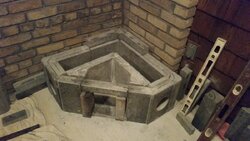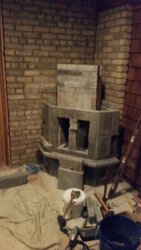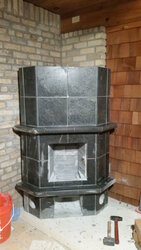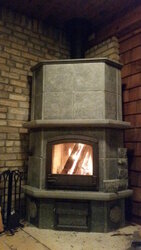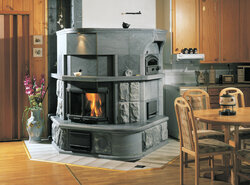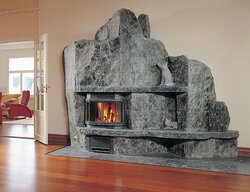Last edited by a moderator:
A Tulikivi Brought Back from the Dead
- Thread starter burnbabyburn139
- Start date
-
Active since 1995, Hearth.com is THE place on the internet for free information and advice about wood stoves, pellet stoves and other energy saving equipment.
We strive to provide opinions, articles, discussions and history related to Hearth Products and in a more general sense, energy issues.
We promote the EFFICIENT, RESPONSIBLE, CLEAN and SAFE use of all fuels, whether renewable or fossil.
You are using an out of date browser. It may not display this or other websites correctly.
You should upgrade or use an alternative browser.
You should upgrade or use an alternative browser.
mellow
Resident Stove Connoisseur
jetsam
Minister of Fire
The room the heater is in is approximately 250 sq. ft of a converted 3 season porch so it is 3 walls of glass and gets a bit cool in the winter. It is somewhat open to rest of the main floor.Let us know how it does and some more details on how many sq feet you are heating with it. Would also love to know the story on why the stones sat for 22 years.
I believe the heater was previously used as a display model for home home shows or something like it because it was clearly siliconed together. We got the stones through a friend of a friend who has since passed away so I don't think I will ever know the full story behind it. The stones are not in the best shape from all the years unprotected outside and likely being moved place to place multiple times.
jatoxico
Minister of Fire
Never quite followed how they operate and the exhaust gas flow in one of those but always wondered how you clean them out. Are those two bungs for that?
That is correct. Later I can try to post a sketch of how the gases flow through this particular heater.Never quite followed how they operate and the exhaust gas flow in one of those but always wondered how you clean them out. Are those two bungs for that?
Thanks for posting. I love Tulikivi heaters and wanted to put one in our house. Cost and soft soil under the proposed location thwarted those plans. It's great that you were able to rescue and rebuild this treasure. The knicks and scratches add character and are part of the interesting history of the heater.
PS: I rotated the images for you but can't change your avatar picture. If you copy the properly oriented pic to your computer that can be used to replace the sleeping avatar, maybe with a little cropping. Let me know if you need help.
PS: I rotated the images for you but can't change your avatar picture. If you copy the properly oriented pic to your computer that can be used to replace the sleeping avatar, maybe with a little cropping. Let me know if you need help.
Last edited:
Simonkenton
Minister of Fire
Beautiful! Hubsch!
I love the Tulikivi and looked long at hard at installing one in my house up here in the NC mountains. Finally figured it was just too much heat for this area.
It is a great design and a great looking stove. The most efficient wood stove in the world.
I love the Tulikivi and looked long at hard at installing one in my house up here in the NC mountains. Finally figured it was just too much heat for this area.
It is a great design and a great looking stove. The most efficient wood stove in the world.
Woody Stover
Minister of Fire
Wow, that looks great in there! 

The exhaust is routed through the stone mass to extract as much heat as possible. You burn a short, hot fire to heat the stone, then the fire burns out but the stone releases heat into the space for many hours. With small, dry wood and the hot fires, I wouldn't think you would have to clean the flue much at all. My BIL has a Russian fireplace, I'll have to ask him about this.Never quite followed how they operate and the exhaust gas flow in one of those but always wondered how you clean them out.
Tulikivi's as well as many other European stoves used to be designed to be dismantled and rebuilt it needed. Some are even built with a clay mortar.
"The clay mortar, used for its elasticity, unlike cement based mortar never set hard and so dismantling and rebuilding a Kakelung was a relatively straight-forward operation."
Glad you were able to put it to good use.
"The clay mortar, used for its elasticity, unlike cement based mortar never set hard and so dismantling and rebuilding a Kakelung was a relatively straight-forward operation."
Glad you were able to put it to good use.
Exactly what I was thinking. I also decided to leave the door as is whit all of its knicks and rough spots.Thanks for posting. I love Tulikivi heaters and wanted to put one in our house. Cost and soft soil under the proposed location thwarted those plans. It's great that you were able to rescue and rebuild this treasure. The knicks and scratches add character and are part of the interesting history of the heater.
PS: I rotated the images for you but can't change your avatar picture. If you copy the properly oriented pic to your computer that can be used to replace the sleeping avatar, maybe with a little cropping. Let me know if you need help.
Thank you for rotating all of those images! Great to have an expert around.
jatoxico
Minister of Fire
This is the part I wonder about. How to clean all the passages which don't seem too accessible. If the stone extracts all the heat then the exhaust temps should be low. Even at startup before things warm up there must be a time where creosote can form.The exhaust is routed through the stone mass to extract as much heat as possible.
Not really. The idea is that they have a hot, short burn with the stove mass (bricks) absorbing the heat as the gasses go through the chambers. This will burn off any creosote that might have been created during the start of end of the burn.This is the part I wonder about. How to clean all the passages which don't seem too accessible. If the stone extracts all the heat then the exhaust temps should be low. Even at startup before things warm up there must be a time where creosote can form.
I spent a year looking at a masonry heater and there is a Tulikivi mason less than an hour from me. The heat/cost ratio is quite bad IMHO and the kicker for me was that they should be placed in the center of a large room. I've got the large room but do not want a stone or brick mound in the middle of it. I spoke to 3 of the top builders in Canada and they all said not to put it on an outside wall. To much heat loss. As to that is the insurance question and the cost. I dropped the idea after that.
I've got a thing for masonry heaters (maybe excessive), and have been studying them for the last 5 years or so. The heater you have appears to be the kind that was built to go in a corner - that is a 90 degree angle. Usually the heaters are away from walls and are rectangular in shape. The 90 degree pattern creates triangular shaped flue channels.
Also a triangular space in the back is created where the outlet pipe may be placed. This heater was designed to fit into tight spaces. Great design for small or tight spaces. Disadvantage - masonry heaters heat best when centrally located in an open type of space. Masonry heaters have little clean-out doors built into the channels that a vacuum head can be stuck in to get the ash.
Your Tulikivi is a contraflow design. Masonry heaters can have their flue channels orientated in many ways. A contraflow has the passage positioned vertically - that is the burn goes straight up hits a barrier then goes straight down (contra = 180 degree turn). What they call a Russian fireplace has the channels positioned horizontally above the firebox - the burn goes right, goes up, goes left, goes up, etc......
Also a triangular space in the back is created where the outlet pipe may be placed. This heater was designed to fit into tight spaces. Great design for small or tight spaces. Disadvantage - masonry heaters heat best when centrally located in an open type of space. Masonry heaters have little clean-out doors built into the channels that a vacuum head can be stuck in to get the ash.
Your Tulikivi is a contraflow design. Masonry heaters can have their flue channels orientated in many ways. A contraflow has the passage positioned vertically - that is the burn goes straight up hits a barrier then goes straight down (contra = 180 degree turn). What they call a Russian fireplace has the channels positioned horizontally above the firebox - the burn goes right, goes up, goes left, goes up, etc......
CentralVAWoodHeat
Minister of Fire
A friend of ours has one in his home. He fires it twice a day and it keeps the entire three floor house comfortably warm even in the coldest temperatures we get in this area. The trade off is the extreme cost. I think he said his ran almost $15,000. With my Jotul, I could buy kiln dried oak for over 10 years to heat my home, and cut none myself, and it still wouldn't make up the cost difference. It just didn't make sense to entertain the idea for a stove like that in our home.
bfitz3
Feeling the Heat
Yup, I got estimates in that range or higher. No one seemed to believe me. The only way is to DIY but in Canada, you can't get it approved easily of it's DIY.I think he said his ran almost $15,000
That's gorgeous!Hey Everyone,
Hope you all will enjoy this Tulikivi I just finished the assembly on. After years sitting in pieces out in the woods and unloved I was able to assemble this gorgeous heater the way it was meant to be when the stones were originally cut in 1994.
Thank you
View attachment 173270 View attachment 173271 View attachment 173272 View attachment 173273
Bravo! Beautiful heaters. Friends downeast have a masonry heater (centrally located) that heats their home efficiently and even allows them to cook in an oven on the kitchen side of the heater. Heaters like these were what heated the palaces of Russia, Germany, and Scandinavia for many years!
Coog
Burning Hunk
mellow
Resident Stove Connoisseur
If you don't mind me asking, how many hours do you have into this build and what was your final cost?
I didn't really keep track of the hours but it was probably 30+ because I did not have any plans and it took a lot of time trying to figure out the design of the firebox and gas channels. I was able to get some outside help to figure the proper design of the heater. The Chimney run also got complicated.If you don't mind me asking, how many hours do you have into this build and what was your final cost?
Total cost is not going to be very relevant in this case because I was extremely lucky and got the heater for for free. My total cost is just over $1000 with chimney and installation supplies.
IThe gentleman who I got it from was a family friend and used to install these. He used this particular heater as a display for home shows. I was able to get it from his wife after he passed.What crazy circumstances led to this work of art being left in pieces in the woods?
Similar threads
- Replies
- 13
- Views
- 804
- Replies
- 5
- Views
- 690
- Replies
- 0
- Views
- 1K
- Replies
- 3
- Views
- 867


